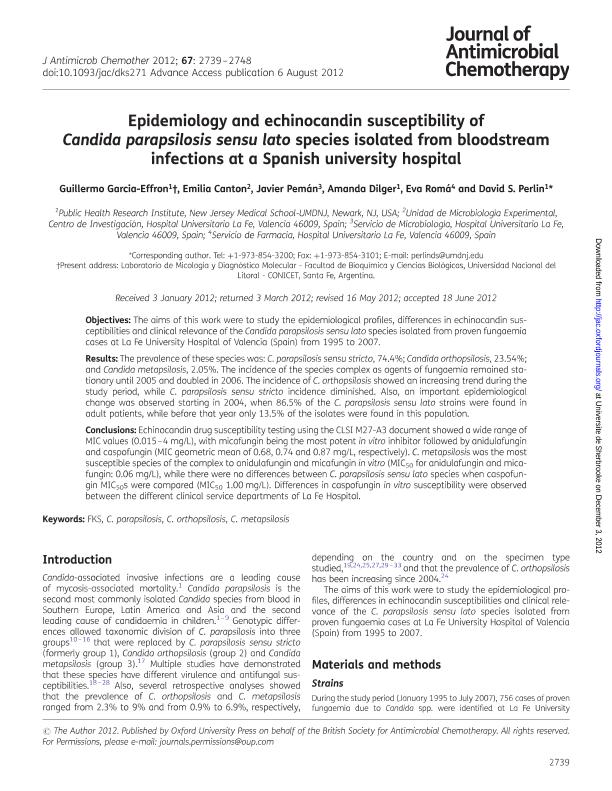Mostrar el registro sencillo del ítem
dc.contributor.author
Garcia, Guillermo Manuel

dc.contributor.author
Canton, Emilia
dc.contributor.author
Pemán, Javier
dc.contributor.author
Dilger, Amanda
dc.contributor.author
Romá, Eva
dc.contributor.author
Perlin, David S.
dc.date.available
2023-05-12T17:27:12Z
dc.date.issued
2012-11
dc.identifier.citation
Garcia, Guillermo Manuel; Canton, Emilia; Pemán, Javier; Dilger, Amanda; Romá, Eva; et al.; Epidemiology and echinocandin susceptibility of Candida parapsilosis sensu lato species isolated from bloodstream infections at a Spanish University Hospital; Oxford University Press; Journal of Antimicrobial Chemotherapy; 67; 11; 11-2012; 2739-2748
dc.identifier.issn
0305-7453
dc.identifier.uri
http://hdl.handle.net/11336/197353
dc.description.abstract
Objectives: The aims of this work were to study the epidemiological profiles, differences in echinocandin susceptibilities and clinical relevance of the Candida parapsilosis sensu lato species isolated from proven fungaemia cases at La Fe University Hospital of Valencia (Spain) from 1995 to 2007.The aims of this work were to study the epidemiological profiles, differences in echinocandin susceptibilities and clinical relevance of the Candida parapsilosis sensu lato species isolated from proven fungaemia cases at La Fe University Hospital of Valencia (Spain) from 1995 to 2007. Results: The prevalence of these species was: C. parapsilosis sensu stricto, 74.4%; Candida orthopsilosis, 23.54%; and Candida metapsilosis, 2.05%. The incidence of the species complex as agents of fungaemia remained stationary until 2005 and doubled in 2006. The incidence of C. orthopsilosis showed an increasing trend during the study period, while C. parapsilosis sensu stricto incidence diminished. Also, an important epidemiological change was observed starting in 2004, when 86.5% of the C. parapsilosis sensu lato strains were found in adult patients, while before that year only 13.5% of the isolates were found in this population. Conclusions: Echinocandin drug susceptibility testing using the CLSI M27-A3 document showed a wide range of MIC values (0.015?4 mg/L), with micafungin being the most potent in vitro inhibitor followed by anidulafungin and caspofungin (MIC geometric mean of 0.68, 0.74 and 0.87 mg/L, respectively). C. metapsilosis was the most susceptible species of the complex to anidulafungin and micafungin in vitro (MIC50 for anidulafungin and micafungin: 0.06 mg/L), while there were no differences between C. parapsilosis sensu lato species when caspofungin MIC50s were compared (MIC50 1.00 mg/L). Differences in caspofungin in vitro susceptibility were observed between the different clinical service departments of La Fe Hospital.Echinocandin drug susceptibility testing using the CLSI M27-A3 document showed a wide range of MIC values (0.015?4 mg/L), with micafungin being the most potent in vitro inhibitor followed by anidulafungin and caspofungin (MIC geometric mean of 0.68, 0.74 and 0.87 mg/L, respectively). C. metapsilosis was the most susceptible species of the complex to anidulafungin and micafungin in vitro (MIC50 for anidulafungin and micafungin: 0.06 mg/L), while there were no differences between C. parapsilosis sensu lato species when caspofungin MIC50s were compared (MIC50 1.00 mg/L). Differences in caspofungin in vitro susceptibility were observed between the different clinical service departments of La Fe Hospital.
dc.format
application/pdf
dc.language.iso
eng
dc.publisher
Oxford University Press

dc.rights
info:eu-repo/semantics/openAccess
dc.rights.uri
https://creativecommons.org/licenses/by-nc-sa/2.5/ar/
dc.subject
C. METAPSILOSIS
dc.subject
C. ORTHOPSILOSIS
dc.subject
C. PARAPSILOSIS
dc.subject
FKS
dc.subject.classification
Enfermedades Infecciosas

dc.subject.classification
Ciencias de la Salud

dc.subject.classification
CIENCIAS MÉDICAS Y DE LA SALUD

dc.title
Epidemiology and echinocandin susceptibility of Candida parapsilosis sensu lato species isolated from bloodstream infections at a Spanish University Hospital
dc.type
info:eu-repo/semantics/article
dc.type
info:ar-repo/semantics/artículo
dc.type
info:eu-repo/semantics/publishedVersion
dc.date.updated
2023-05-12T14:51:41Z
dc.journal.volume
67
dc.journal.number
11
dc.journal.pagination
2739-2748
dc.journal.pais
Reino Unido

dc.journal.ciudad
Oxford
dc.description.fil
Fil: Garcia, Guillermo Manuel. Public Health Research Institute; Estados Unidos. Consejo Nacional de Investigaciones Científicas y Técnicas. Centro Científico Tecnológico Conicet - Santa Fe; Argentina
dc.description.fil
Fil: Canton, Emilia. Hospital Universitario la Fe; España
dc.description.fil
Fil: Pemán, Javier. Hospital Universitario la Fe; España
dc.description.fil
Fil: Dilger, Amanda. Public Health Research Institute; Estados Unidos
dc.description.fil
Fil: Romá, Eva. Hospital Universitario la Fe; España
dc.description.fil
Fil: Perlin, David S.. Public Health Research Institute; Estados Unidos
dc.journal.title
Journal of Antimicrobial Chemotherapy

dc.relation.alternativeid
info:eu-repo/semantics/altIdentifier/url/https://academic.oup.com/jac/article/67/11/2739/708337
dc.relation.alternativeid
info:eu-repo/semantics/altIdentifier/doi/http://dx.doi.org/10.1093/jac/dks271
Archivos asociados
